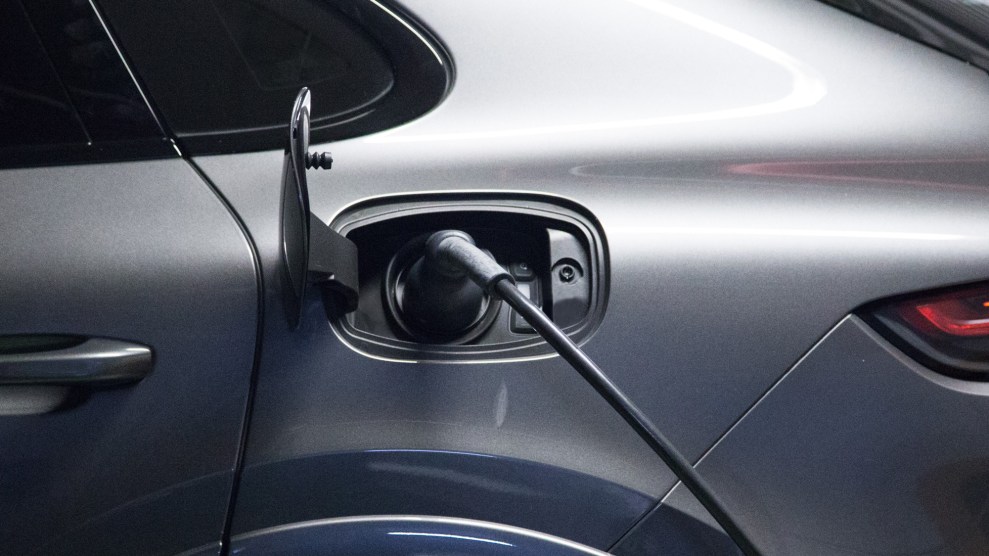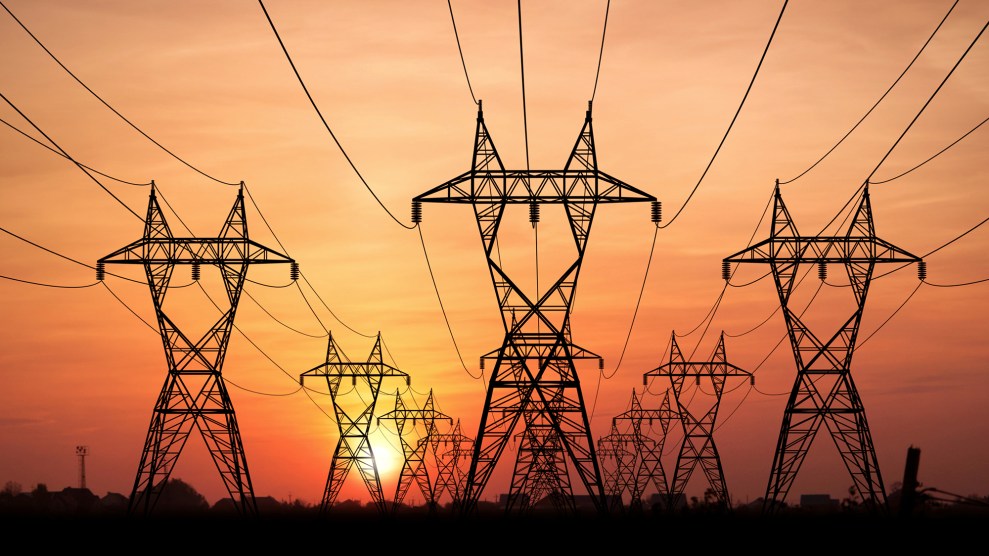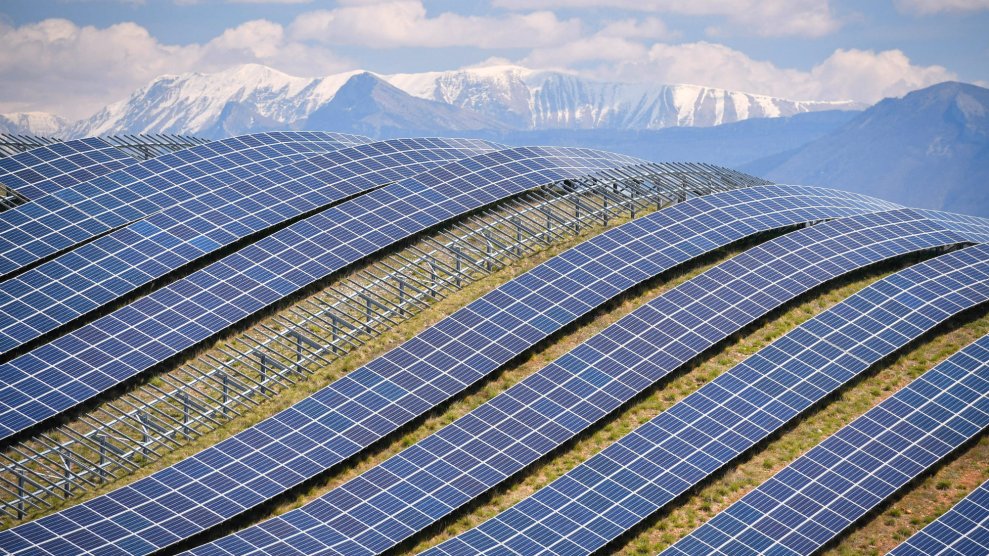
Getty
The United States is on the brink of its most consequential transformation since the New Deal. Read more about what it takes to decarbonize the economy, and what stands in the way, here. This story was originally published by Wired and is reproduced here as part of the Climate Desk collaboration.
At first glance, electric vehicles seem like rolling disasters for the power grid. Surely the ancient, creaky network in the United States can’t handle the demand for charging those massive batteries. But a new analysis suggests that just a fraction of EV owners could make the grid more flexible and reliable by plugging into a system called vehicle-to-grid charging (V2G), or bidirectional charging.
V2G means that when demand spikes, utilities can pay EV owners to tap into their idle car batteries—a distributed network of ready-to-go backup power. That’ll be critical as we transition to renewables: Wind and solar power won’t always be available, so we need to bank energy when supplies are low. “We can use some energy that’s already stored in our EVs to give back to the grid,” says Chengjian Xu, an industrial ecologist at Leiden University in the Netherlands and lead author of the paper, which was recently published in Nature Communications. Last year, the Natural Resources Defense Council estimated that if California exploited all of the 14 million EVs it’ll have by 2035, they could power every home in the state for three days.
Xu’s modeling finds that by the year 2030, only 30 percent of the world’s EV owners would need to opt in to V2G programs to meet energy storage demand. That’s a global average; each country differs in how quickly it’s adopting EVs, how much energy it uses, and the pace at which it’s switching to renewables, among other variables. Depending on the country, the modeling found that participation rates of between 12 and 43 percent of EVs would suffice.
Better yet, the paper suggests that over time, the system won’t even need to rely on parked cars—their old batteries could be semi-retired and repurposed into large stationary power storage arrays. EV batteries usually need replacing once they get to 70 or 80 percent capacity and a vehicle’s range begins to suffer. Depending on how much you drive and the climate where you live, a battery might last 10 to 20 years—which means that batteries in early models of popular EVs, like Teslas and the Nissan Leaf, are now reaching retirement.
The team’s modeling finds that if we did that for half of used batteries, we’d need less than 10 percent of EV owners to participate. “Thankfully, battery degradation doesn’t seem to be limiting the total available energy that could be used for V2G,” says Paul Gasper, a staff scientist at the National Renewable Energy Lab who studies battery degradation and coauthored the paper.
Using parked cars as battery banks is a powerful way to shift energy demand. If drivers charge their cars during the day at offices or as they run errands (when the sun is shining and there’s lots of solar power being fed to the grid), they can drive home and provide extra power to their community in the early evening, right as demand soars because people are returning home and switching on appliances. EV owners would also agree that their power company could tap into their battery during extreme heat events, when lots of people are running air conditioners.
The key is to stagger supply and demand between when people need power to drive and when they need it to run their homes. “Yes, if everyone plugged in at the same time and charged a car at full power, that would not work on this antiquated model of charging,” says Jan Kleissl, director of the Center for Energy Research at the University of California, San Diego, who wasn’t involved in the new modeling. “But if we are able to vary demand, then we can certainly make it work because no vehicle needs to charge 24 hours a day.”
Commercial and government vehicles, like public transit or school buses, can also hook into V2G. A company called Nuvve, which develops V2G technology, has been working with school districts in Southern California to turn their buses—with their prodigious batteries—into V2G assets. School buses run on a reliable schedule, so their batteries can feed power to the grid after the kids are dropped off, then recharge in time to pick them up the next day. On weekends and holidays, a bus battery would be available at all times.
One of the perks of V2G is that it can subsidize the cost of owning an EV: The more it sits in your garage, the more money you make. “If you’re the type of person who can work from home and doesn’t have to drive your electric vehicle very often, then participating in V2G could likely make some revenue,” says Gasper. “So you’re providing more utility for the vehicle to help divert the cost of owning the vehicle, which is huge.”
You might think extra use would rapidly degrade the battery, but that’s not always true. “If you own an EV and don’t drive it very often, V2G could actually extend the lifetime of your vehicle battery,” says Gasper. Discharging it from time to time is essentially exercising it to keep it healthy. “There are two ways to kill a battery, and one is to have it sit fully charged all the time—why laptop batteries die very quickly. And the other one is to use it constantly.”
Wide-scale V2G faces some major challenges, though. For one thing, not every EV is equipped to do bidirectional charging, though automakers are increasingly adopting those capabilities for vehicles like the new Nissan Leaf and the Ford F-150. It also requires a special charger that reverses the current to pull energy out of the battery. Given those limitations, V2G is still in early development, with around 100 pilot programs running worldwide.
For another, there’s no industry standard for the intersecting components of V2G: Right now, there’s a patchwork of vehicles from different manufacturers plugging into different charging systems that themselves plug into different grids.
And utilities might offer different compensation, whether to individual EV owners or a fleet operators. “One of the things we really need to learn is: What are the incentives that we need to offer drivers in both categories to get them to participate?” says Joseph Vellone of Ev.energy, which makes software that regulates EV charging and is working with a consortium of charger manufacturers and automakers to test V2G strategies.
A utility might subsidize or rebate the cost of bidirectional chargers, for example. Or a state might enact a law that says its utilities have to pay a certain rate for a specific amount of battery power, the way homeowners who install solar panels are compensated for sending excess power back to the grid. “We have this asset, and if we have a certain degree of flexibility, we can leverage it when the grid might need it the most,” says Patricia Hidalgo-Gonzalez, who is director of the Renewable Energy and Advanced Mathematics Laboratory at the University of California, San Diego, and wasn’t involved in the new paper. “The question is: How this will get materialized in the different utilities?”
And finally, EVs remain expensive, often out of reach for lower-income drivers. “A lot of the cheaper vehicles that people will be buying will be secondhand EVs, and they won’t have the bidirectional charging in them unless they get retrofitted,” says Paul Behrens, an industrial ecologist at Leiden University and coauthor of the new paper. Plus, if you’re not a homeowner, you may not have the luxury of a dedicated garage socket you can plug your car into; apartment buildings with chargers are few and far between.
Yet while there are still hurdles to overcome, automakers, charger manufacturers, and some utilities are already collaborating to turn EVs into grid assets, not burdens. “Bidirectional charging is really the key to enabling EVs as being a viable backup power option, and that’s really where the future lies,” says Paul Doherty, a spokesperson for the Pacific Gas and Electric Company, one of California’s utilities. “It’s just such a huge shift in the way we think about EVs and personal vehicles overall. It’s not just about getting from point A to point B anymore.”















